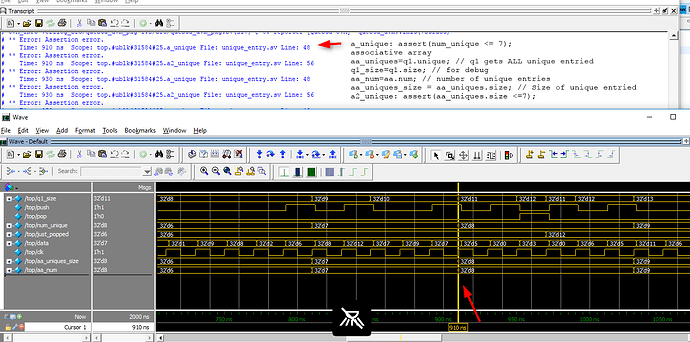In reply to ben@SystemVerilog.us:
My co-author Srini (http://cvcblr.com/home ), a very knowledgeable trainer/consultant pointed out that instead of me maintaining the number of unique entries, I could have used the array method unique
From 1800'2012:
unique() returns all elements with unique values or whose expression evaluates to a unique value. The queue returned contains one and only one entry for each of the values found in the array. The ordering of the returned elements is unrelated to the ordering of the original array.
int IA[int], qi[$];
string SA[10], qs[$];
// Find all unique string elements
qs = SA.unique;
// Find all unique strings in lowercase
qs = SA.unique( s ) with ( s.tolower );
//****** for the model, the new things are
int aa_uniques_size;
int aa_uniques[$]; // for use with the unique method
// .... in the always
aa_uniques=q1.unique;
aa_uniques_size = aa_uniques.size;
a2_unique: assert(aa_uniques.size <=7);
I added this feature to my model. The new model is at
http://SystemVerilog.us/fv/unique_entry.sv
Waveforms is at
// I have a synchronous FIFO. The depth of the FIFO is 32.
// Everytime the FIFO has 7 or any "n" unique elements inside it,
// "unique" signal goes HIGH. How do I test the "unique" signal going high
// in SystemVerilog or UVM? How would my scoreboard look like?
import uvm_pkg::*; `include "uvm_macros.svh"
module top;
bit clk, pop, push;
int data=8, q1_size, aa_num, just_popped, aa_uniques_size;
int aa[int]; // associative array
int q1[$]; // queue, emulating the fifo
int num_unique=0;
int aa_uniques[$]; // for use with the unique method
// NEW solution
/* unique() returns all elements with unique values or whose expression evaluates to a unique value.
The queue returned contains one and only one entry for each of the values found in the array. The
ordering of the returned elements is unrelated to the ordering of the original array
int IA[int], qi[$];
string SA[10], qs[$];
// Find all unique string elements
qs = SA.unique;
// Find all unique strings in lowercase
qs = SA.unique( s ) with ( s.tolower );
*/
always @(posedge clk) begin
automatic int temp_pop;
if(push) begin : push1 // if(push && !pop) begin : push_no_pop
if(!aa.exists(data)) begin : is_unique
aa[data]=1; // flag data into associative array
num_unique = num_unique+1'b1; // incremnet number of uniques
q1.push_front(data); // maintain the queue
end : is_unique
else begin : is_not_unique // but is in the queue
aa[data]+=1'b1; // keep track of count
// num_unique <= num_unique+1'b1; // incremnet number of uniques
q1.push_front(data); // maintain the queue
end : is_not_unique
end : push1
if(pop && q1.size != 0) begin : pop_q // if(pop && !push && q1.size != 0)
temp_pop=q1.pop_back(); // maintain the queue
aa[temp_pop]-=1'b1; // keep track of count
just_popped <= temp_pop;
if(aa[temp_pop]==0) begin : flushed
num_unique = num_unique - 1'b1; // decrement uniques
aa.delete(temp_pop); // delete the associative array entry
end : flushed
end : pop_q
a_unique: assert(num_unique <= 7);
// aa_uniques.delete; // clear the temp associative array
aa_uniques=q1.unique;
// debug
q1_size=q1.size; // for debug
aa_num=aa.num; // number of unique entries
aa_uniques_size = aa_uniques.size;
a2_unique: assert(aa_uniques.size <=7);
end
initial forever #10 clk=!clk;
initial begin
repeat(5) push <= 1'b1;
repeat(200) begin
@(posedge clk); #2;
if (!randomize(push, pop, data) with
{ push dist {1'b1:=1, 1'b0:=2};
pop dist {1'b1:=1, 1'b0:=8};
data dist {[1:12]:=1, [0:0]:=3};
}) `uvm_error("MYERR", "This is a randomize error")
end
$stop;
end
endmodule
Ben Cohen
http://www.systemverilog.us/ ben@systemverilog.us
For training, consulting, services: contact http://cvcblr.com/home
- SVA Handbook 4th Edition, 2016 ISBN 978-1518681448
- A Pragmatic Approach to VMM Adoption 2006 ISBN 0-9705394-9-5
- Using PSL/SUGAR for Formal and Dynamic Verification 2nd Edition, 2004, ISBN 0-9705394-6-0
- Real Chip Design and Verification Using Verilog and VHDL, 2002 isbn 978-1539769712
- Component Design by Example ", 2001 ISBN 0-9705394-0-1
- VHDL Coding Styles and Methodologies, 2nd Edition, 1999 ISBN 0-7923-8474-1
- VHDL Answers to Frequently Asked Questions, 2nd Edition ISBN 0-7923-8115
